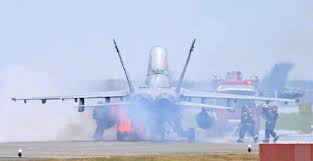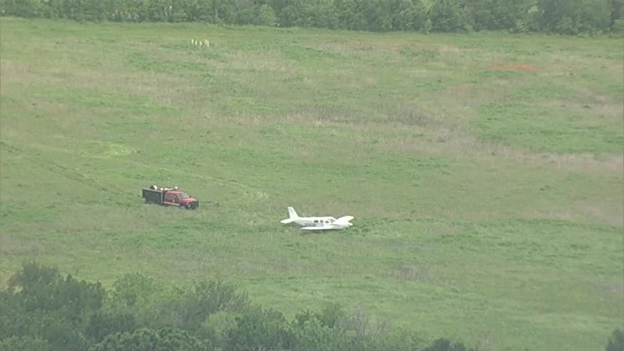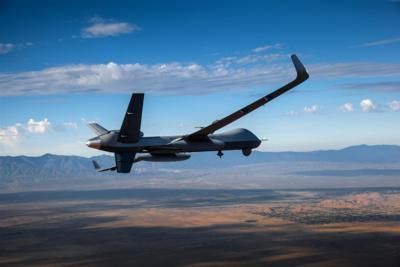ARFF Daily News
Published on:
Thursday the 18th of April, 2024
These are the stories for today...
Of note, the story regarding the USAF report on the September 2023 fatal accident at Gray Butte Airfield where the victim walked into a rotating propeller of an MQ-9A Reaper drone during a ground test. The report highlights the "...importance of comprehensive training, clear communication, and the need for constant vigilance in maintaining situational awareness, especially in environments where the stakes are high and the equipment involves significant risk."
Be safe out there!
Tom
White smoke from US military aircraft at Iwakuni Air Base
Around 12:30 p.m. on the 17th, a problem occurred with a U.S. military aircraft about to take off at the U.S. military's Iwakuni base in Iwakuni City, Yamaguchi Prefecture. There has been no impact on operations at Iwakuni Kintaikyo Airport, which uses the runway.
Witnesses said the FA18 Super Hornet fighter-attack jet was about to take off when white smoke billowed from the aircraft, causing it to slow down and come to rest on the side of the runway. While extinguishing the fire, flames appeared from the rear tires. A man who witnessed the incident said, ``I was surprised to see flames.''
https://nordot.app/1153219439591342333?c=768367547562557440

Small plane crashes near Denton airport
By FOX 4 Staff
DENTON, Texas - The pilot of a small plane survived a crash in Denton Wednesday morning.
The Denton Fire Department said it happened just north of the Denton Enterprise Airport on Jim Crystal Road.
The single-engine aircraft reportedly lost power and went down in a field.
The pilot was the only person on board at the time and walked away without any serious injuries.
Crews are still at the scene for an investigation and cleanup.
https://www.fox4news.com/news/denton-airport-plane-crash

Tragic: Test Engineer Killed by Prop Lost Situational Awareness
Engineer Dies of Prop Strike at Gray Butte Airfield
The tragic incident involving Stephanie Cosme at Gray Butte Airfield underscores critical issues in operational safety and situational awareness in high-risk environments. Cosme, a 32-year-old test engineer employed by Sumaria Systems, LLC, was fatally injured on September 7, 2023, when she walked into a rotating propeller of an MQ-9A Reaper drone during a ground test.
The Air Force's investigation into the accident highlighted several key factors contributing to the unfortunate event. Firstly, the report indicates that Cosme was inadequately trained on how to properly approach the aircraft while conducting telemetry readings. This lack of proper training was pivotal, as it set the stage for the second factor: loss of situational awareness. Cosme was focused on the handheld device she was using to take measurements, which distracted her from her surroundings, including the dangers posed by the operational propeller.
Brig. Gen. Lance R. French pointed out additional systemic issues that exacerbated the situation. There was a noted lack of communication between the contractor test team and the ground support workers. Moreover, the urgency to conduct tests, which were delayed prior, led to a rushed execution on that day. These conditions created a chaotic environment where critical safety protocols may have been overlooked.
The final moments before the accident were particularly harrowing, as colleagues realized the imminent danger and attempted to alert Cosme by shouting and waving. Unfortunately, their efforts were too late to avert the tragedy.
This incident serves as a stark reminder of the importance of comprehensive training, clear communication, and the need for constant vigilance in maintaining situational awareness, especially in environments where the stakes are high and the equipment involves significant risk.
FMI: Airforce.com

NTSB Final Report: Cessna 172C
After Flying For About 4 Hours, The Engine Lost Power And (Pilot) Executed A Forced Landing On A Road
Location: Wichita, Kansas Accident Number: CEN24LA019
Date & Time: October 20, 2023, 18:55 Local Registration: N1413Y
Aircraft: Cessna 172C Aircraft Damage: Substantial
Defining Event: Fuel exhaustion Injuries: 1 None
Flight Conducted Under: Part 91: General aviation - Personal
Analysis: The pilot reported that she filled the airplane with fuel before departure. After flying for about 4 hours, the engine lost power and she executed a forced landing on a road about 1.5 miles from the destination airport. During the landing roll, the airplane impacted two street signs and a power pole guy wire which resulted in substantial damage to the airplane’s left wing and fuselage. The pilot reported that there were no preaccident mechanical malfunctions or failures that would have precluded normal operation.
Postaccident examination of the airplane revealed no anomalies with the fuel system; the fuel tanks were empty, and there was no evidence of a fuel leak. About 8 ounces of fuel were recovered from the gascolator.
The pilot noted that verification of total fuel onboard before each departure and more accurate usage of the airplane’s performance charts could have prevented the accident.
Probable Cause and Findings: The National Transportation Safety Board determines the probable cause(s) of this accident to be -- The pilot’s inadequate preflight inspection and fuel planning and improper in-flight decisionmaking, which resulted in a total loss of engine power due to fuel exhaustion.
FMI: www.ntsb.gov

Today in History
52 Years ago today: On 18 April 1972 an East African Vickers VC-10 jetliner overran the Addis Ababa runway after aborting takeoff due to a tyre failure; killing 43 out of 107 occupants.
Date: Tuesday 18 April 1972
Time: 09:39
Type: Vickers Super VC10-1154
Owner/operator: East African Airways Corp. - EAAC
Registration: 5X-UVA
MSN: 881
Year of manufacture: 1966
Total airframe hrs: 18586 hours
Engine model: Rolls-Royce Conway 550
Fatalities: Fatalities: 43 / Occupants: 107
Aircraft damage: Destroyed, written off
Category: Accident
Location: Addis Ababa-Bole Airport (ADD) - Ethiopia
Phase: Take off
Nature: Passenger - Scheduled
Departure airport: Addis Ababa-Haile Selassie I International Airport (ADD/HAAB)
Destination airport: Roma-Fiumicino Airport (FCO/LIRF)
Investigating agency: CAA Ethiopia
Confidence Rating: Accident investigation report completed and information captured
Narrative:
East African Airways Flight 720 to London via Addis Ababa and Rome departed Nairobi at 06:55 hours. The flight to Addis Ababa was uneventful and the VC10 landed there at 08:23. During the transit stop at Addis Ababa, some freight was off-loaded together with 40 passengers. Fifteen passengers joined the flight and the airplane was refuelled. Start up clearance was given at 09:21 hours and the aircraft taxied out six minutes later via the eastern taxiway for takeoff on runway 07. The tower advised the aircraft that the wind was 5 knots and variable in direction. At 09:32 hours, as the aircraft was backtracking to the takeoff point, the pilot reported a number of dead birds on the runway. He requested that these birds be removed before the aircraft took off. A fire truck was dispatched to take care of this. The aircraft continued to backtrack down the runway and turned in the pad at the end. It then lined up on the runway and stopped a short distance from the threshold.
At 09:38:40 hours, the tower cleared the aircraft for takeoff. Shortly after the aircraft had passed the mid-point of the runway, at or just below the V1 speed, the nose wheel ran over a steel jacking pad. This jacking pad belonged to a Cessna 185 that had departed 4:40 hrs earlier. The pad punctured the right hand nose wheel tire. A loud bang was heard and severe vibration was felt on the flight deck. Almost immediately after the nose wheel tire had burst, the nose of the aircraft rose momentarily and then come down. The flight crew decided to abort the takeoff. The engines were throttled back and reverse thrust was selected. The aircraft continued down the runway, veering slightly to the right.
Then the no.1 rear main tire burst. Just before the aircraft reached the end of the runway, it veered slightly to the left and ran approximately parallel to the centre line. After crossing a storm drain located at the end of the runway at right angles to the centre line, the aircraft became momentarily airborne as it left the lip of the embankment on which the 60 m stopway was laid. As it did so, the left outer wing of the aircraft struck a steel lattice tower forming part of the approach lighting system to runway 25. This ruptured the no. 1A fuel tank and the released fuel promptly ignited. Sixty metres beyond the end of the runway the aircraft fell heavily on to the lower ground 10.6 m below the runway level. It broke up immediately on impact and after sliding a short distance, came to rest and caught fire.
PROBABLE CAUSE: "The accident was due to a partial loss of braking effort arising from incorrect re-assembly of part of the braking system, as a result of which the aircraft could not be stopped within the emergency distance remaining following a properly executed abandoned take-off procedure."

Mailing Address
Subscribe to our newsletter
Contact Us
We will get back to you as soon as possible.
Please try again later.
